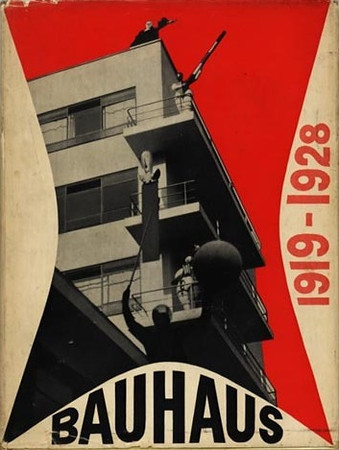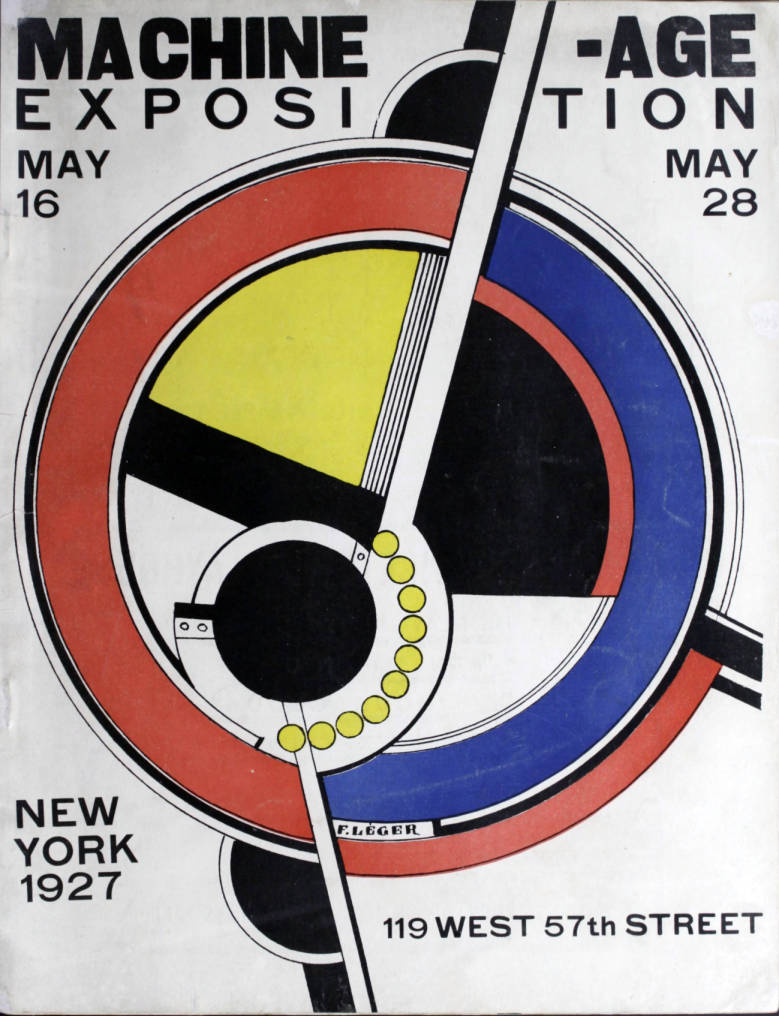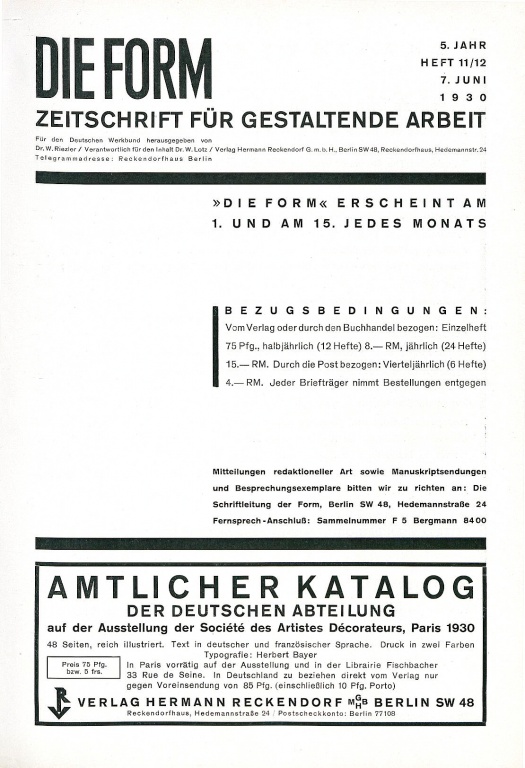Herbert Bayer, Walter Gropius, Ise Gropius (eds.): Bauhaus 1919–1928 (1938)
Filed under book, catalogue | Tags: · 1920s, architecture, art, art history, avant-garde, bauhaus, design, graphic design, industrial design, painting, photography, sculpture, typography


Bauhaus 1919-1928 remains one of the most valuable accounts of the Bauhaus school. The book was published in conjunction with the Museum Of Modern Art exhibition (December 7, 1938-January 30, 1939) and is a point-for-point record of actual programs and projects at the Bauhaus, prepared by Herbert Bayer under the general editorship of Walter Gropius and Ise Gropius and with the collaboration of a dozen other Bauhaus teachers — including Kandinsky, Klee, Feininger, Schlemmer, Itten, Moholy-Nagy, Albers, and Breuer. Rather than a retrospective history, it is a collection of photographs, articles, and notes prepared on the field of action. It may be considered as much a work of the Bauhaus as it is a work about it.
Includes work by all the Bauhaus faculty including Walter Gropius, Paul Klee, Wassily Kandinsky, Laszlo Moholy-Nagy, Marcel Breuer, Herbert Bayer, Josef Albers, Lyonel Feininger, Oskar Schlemmer, Hannes Meyer, Mies van der Rohe, Anni Albers, Otti Berger, Gunta Stolzl, Max Bill and many others.
The exhibition gave the first comprehensive review of the development of the institute under Gropius (no material from the later Bauhaus was shown). Preparation and technical arrangements were entrusted to Herbert Bayer, paving the way for his own emigration to America shortly afterwards. An accompanying Bulletin was a privilege, sent to members of MOMA. (Source)
Bauhaus 1919-1928
With a Preface by Alfred H. Barr, Jr.
Publisher Museum of Modern Art, New York, 1938
224 pages
via Joaquim Moreno, update via MoMA
The Bulletin of the Museum of Modern Art 6, Vol. 5 (Dec 1938): Bauhaus Exhibition
Publisher Museum of Modern Art, New York, 1938
8 pages
via David Levine
PDF (Book, 42 MB, updated on 2016-9-17)
PDF (Bulletin)
Machine-Age Exposition, catalogue (1927)
Filed under catalogue | Tags: · architecture, art, avant-garde, constructivism, cubism, design, industrial design, machine


Poster, via Beinecke Rare Book & Manuscript Library
Exhibition catalogue of the Machine-Age Exposition, held on May 16-28, 1927, at 119 West 57th Street in New York, and advertised as the first event bringing together “architecture, engineering, industrial arts and modern art.”
The exhibition was initiated by Jane Heap of The Little Review, a New York literary magazine, and organised along with Société des urbanistes, Brussels; U.S.S.R. Society of Cultural Relations with Foreign Countries; Kunstgewerbeschule, Vienna; Czlonkowie Group Praesens, Warsaw; Architects D.P.L.G, Paris; and Advisory American Section.
The volume contains a panorama of European and American architecture and art, with photo documentation, and following articles: “Foreword: Architecture of this Age” by Hugh Ferriss, “The Aesthetic of the Machine and Mechanical Introspection in Art” by Enrico Prampolini, “Machine and Art” by Alexander Archipenko, “The Americanization of Art” by Louis Lozowick, “French Architecture” by André Lurçat, “Architecture Opens Up Volume” by Szymon Syrkus, “Machine-Age Exposition” by Jane Heap, “The Poetry of Forces” by Mark Turbyfill, and “Modern Glass Construction” by Frederick L. Keppler.
The artists committee of the exhibition included Alexander Archipenko, Robert Chanler, Andrew Dasberg, Charles Demuth, Muriel Draper, Marcel Duchamp, Josef Frank, Hugh Ferriss, Louis Lozowick, André Lurçat, Elie Nadleman, Man Ray, Boardman Robinson, Charles Sheeler, Ralph Steiner, Szymon Syrkus and L. Van der Swallmen.
Represented countries: “America”, Austria, Belgium, France, Germany, Poland and Russia.
Published in New York, 1927
44 pages
via Hagley Digital Archives
Commentary (E. B. White, The New Yorker, 1927): “That the machine is the tutelary symbol of the universal dynamism can be discovered at the Machine Age Exposition. […] Drawings, photographs, cubist and constructionist figures by reputable modern artists are side by side with cogs, motor boat propellers, Crane valves, insides of pianos and diving suits.”
Machine-Age Exposition at Monoskop wiki
Comment (0)Die Form: Zeitschrift für gestaltende Arbeit (1922-1935) [German]
Filed under magazine | Tags: · advertising, architecture, art, art criticism, avant-garde, bauhaus, city, design, graphic design, industrial design, photography, typography



Die in den Jahren 1925-1934 erscheinende Zeitschrift „Die Form“ wurde von Walter Curt Behrendt für den Deutschen Werkbund herausgeben. Sie erschien im Berliner Verlag Hermann Reckendorf; ihre Auflage überschritt nie die Marke von 5.000 Exemplaren. Der Untertitel lautete von 1929 bis 1934 „Zeitschrift für gestaltende Arbeit“.
Bereits im Jahr 1922 hatte es einen ersten Versuch gegeben die Werkbund-Zeitschrift zu etablieren. So heißt es im Geleitwort des ersten Bandes (1925) von Walter Curt Behrendt „Mit dieser Zeitschrift setzt der Deutsche Werkbund ein Unternehmen fort, das bereits vor längerer Zeit begonnen, unter dem Druck der wirtschaftlichen Verhältnisse zunächst wieder aufgegeben werden mußte. Die Zeitschrift wird die Aufgaben der Formgestaltung für alle Gebiete des gewerblichen und künstlerischen Schaffens behandeln.“
Behrendt blieb bis Ende 1926 Herausgeber und wurde dann durch Walter Riezler abgelöst. Die Gestaltung der typographischen Umschläge lag in den Händen von Joost Schmidt. Er war seit 1919 am Bauhaus und leitete seit 1925 die Plastische Werkstatt. 1934/35 wurde die Zeitschrift von den Nationalsozialisten übernommen und dann eingestellt. (Source)
Publishers: Hermann Reckendorf, Munich and Berlin, 1922 & 1927-1932; Kurt Schroeder, Bonn and Berlin, 1925-1926; W. & S. Loewenthal, Berlin, 1933 (1-3); Wendt & Matthes, Berlin, 1933 (4-12), 1934 (1); Deutscher Werkbund, Berlin, 1934 (2-6); Walter de Gruyter, Berlin, 1935
via Universitätsbibliothek Heidelberg
Volumes (single PDFs) and separate articles (PDF, HTML):
Volume 1, 1922 (Die Form: Monatschrift für gestaltende Arbeit, 4 Issues)
Volume 1, 1925-1926 (15 Issues)
Volume 2, 1927 (Die Form: Monatschrift für gestaltende Arbeit, 12 Issues)
Volume 3, 1928 (Die Form: Monatschrift für gestaltende Arbeit, 15 Issues)
Volume 4, 1929 (24 Issues)
Volume 5, 1930 (24 Issues)
Volume 6, 1931 (12 Issues)
Volume 7, 1932 (12 Issues)
Volume 8, 1933 (12 Issues)
Volume 9, 1934 (6 Issues)
Volume 10, 1935 (1 Issue)

